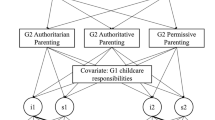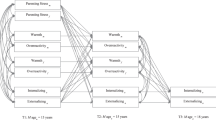Abstract
Behavior problems influence development at multiple stages over the lifespan. The present study explores the relations between maternal behavior prior to parenting and offspring behavior problems in childhood and adolescence using National Longitudinal Survey of Youth data (N = 2,820 dyads with 50.0 % male offspring and 52.2 % of ethnic/racial minority status). Index scores for behavior problems were created for mothers prior to parenting and for offspring at two time points. Path analyses indicated that maternal behavior problems prior to parenthood predicted offspring being at increased risk for behavior problems in childhood and adolescence. Mothers’ behavior had a significant influence on adolescent behavior, even after childhood behavior problems and demographic covariates were taken into account. Post-hoc analyses demonstrated the stability of behavior problems is especially strong for males. Results support a long tradition of research and the external validity of the stability of behavior problems as well as the importance of maternal behavior prior to parenthood for their future offspring across development. Clinical and policy implications are discussed.


Similar content being viewed by others
References
American Psychiatric Association (2000). Diagnostic and statistical manual of mental disorders (4th ed., text rev.). Washington, DC.
Belsky, J., & Beaver, K. M. (2011). Cumulative-genetic plasticity, parenting, and adolescent self-regulation. Journal of Child Psychology and Psychiatry, 52, 619–626.
D’Onofrio, B. M., Slutske, W. S., Turkheimer, E., Emery, R. E., Harden, K. P., Heath, A. C., et al. (2007). Intergenerational transmission of childhood conduct problems: A children of twins study. Archives of General Psychiatry, 64, 820–829.
Dodge, K. A., Pettit, G. S., & Bates, J. E. (1994). Socialization mediators of the relation between socioeconomic status and child behavior problems. Child Development, 65(2), 649–665. doi:10.1111/j.1467-8624.1994.tb00774.x.
Ehrensaft, M. K., Cohen, P., Brown, J., Smailes, E., Chen, H., & Johnson, J. G. (2003). Intergenerational transmission of partner violence: A 20-year prospective study. Journal of Consulting and Clinical Psychology, 71, 741–753.
Fatori, D., Bordin, I. A., Curto, B. M., & de Paula, C. S. (2013). Influence of psychosocial risk factors on the trajectory of mental health problem from childhood to adolescence: A longitudinal study. BMC Psychiatry, 17, 13–31.
Fite, P. J., Wynn, P., & Pardini, D. A. (2009). Explaining discrepancies in arrest rates between Black and White male juveniles. Journal of Consulting and Clinical Psychology, 77, 916–927. doi:10.1037/a0016626.
Frick, P. J., Barry, C. T., & Kamphaus, R. W. (2010). Clinical assessment of child and adolescent personality and behavior (3rd ed.). New York: Springer. doi: 10.1007/978-1-4419-0641-0.
Goldstein, R. B., Prescott, C. A., & Kendler, K. S. (2001). Genetic and environmental factors in behavior problems and adult antisocial behavior among adult female twins. Journal of Nervous and Mental Disease, 189(4), 201–209. doi:10.1097/00005053-200104000-00001.
Harold, G. T., Rice, F., Hay, D. F., Boivin, J., van den, B. M., & Thapar, A. (2010). Familial transmission of depression and antisocial behavior symptoms: Disentangling the contribution of inherited and environmental factors and testing the mediating role of parenting. Psychological Medicine, 22, 1–11.
Herpertz, S. C., Vloet, T., Mueller, B., Domes, G., Willmes, K., & Herpetz-Dahlmann, B. (2007). Similar autonomic responsivity in boys with behavior disorder and their fathers. Journal of the American Academy of Child and Adolescent Psychiatry, 46, 535–544.
Humbad, M. N., Donnellan, M. B., Iacano, W. G., & Burt, S. A. (2010). Externalizing psychopathology and marital adjustment in long-term marriages: Results from a large combined sample of married couples. Journal of Abnormal Psychology, 119, 151–162. doi:10.1037/a0017981.
Kerr, D. C., Capaldi, D. M., Pears, K. C., & Owen, L. D. (2009). A prospective three generational study of fathers’ constructive parenting: Influences from family of origin, adolescent adjustment, and offspring temperament. Developmental Psychopathology, 45, 1257–1275.
Kimonis, E. R., & Frick, P. J. (2010). Etiology of oppositional defiant disorder and behavior disorder: Biological, familial and environmental factors identified in the development of disruptive behavior disorders. In R. C. Murrihy, A. D. Kidman, & T. H. Ollendick (Eds.), Clinical handbook of assessing and treating behavior problems in youth (pp. 49–76). New York: Springer. doi: 10.1007/978-1-4419-6297.
Klein, R. G., Mannuzza, S., Olazagasti, M. A., Roizen, E., Hutchison, J. A., Lashua, E. C., et al. (2012). Clinical and functional outcome of childhood attention-deficit/hyperactivity disorder 33 years later. Archives of General Psychiatry, 69, 295–303.
Lindsey, M. A., Chambers, K., Pohle, C., Beall, P., & Lucksted, A. (2013). Understanding the behavioural determinants of mental health service use by urban, under-resourced black youth: Adolescent and caregiver perspectives. Journal of Child and Family Studies, 22, 107–121.
Martin, S. L., & Burchinal, M. R. (1992). Young women’s antisocial behavior and the later emotional and behavioral health of their children. American Journal of Public Health, 82, 1007–1010.
Miller, C. J., Miller, S. R., Trampush, J., McKay, K. E., Newcorn, J. H., & Halperin, J. M. (2006). Family and cognitive factors: Modeling risk for childhood aggression at home and school. Journal of the American Academy of Child and Adolescent Psychiatry, 45, 355–363.
Moffitt, T. E., Caspi, A., Dickson, N., Silva, P., & Stanton, W. (1996). Childhood-onset versus adolescent-onset antisocial behavior problems in males: Natural history from ages 3 to 18 years. Development and Psychopathology, 8, 399–424. doi:10.1017/S0954579400007161.
Muthen, L., & Muthen, B. O. (2011). Mplus (6th ed.). Los Angeles: Author.
Odgers, C. L., Caspi, A., Russell, M. A., Sampson, R. J., Arseneault, L., & Moffitt, T. E. (2012). Supportive parenting mediates neighborhood socioeconomic disparities in children’s antisocial behavior from ages 5 to 12. Developmental Psychopathology, 24, 705–721. doi:10.1017/S0954579412000326.
Raine, A., Moffitt, T. E., Caspi, A., Loeber, R., Stouthamer-Loeber, M., & Lynam, D. (2005). Neurocognitive impairments in boys on the life-course persistent antisocial path. Journal of Abnormal Psychology, 114, 38–49.
Randolph, K. A., Rose, R. A., Fraser, M. W., & Orthner, D. K. (2004). Examining the impact of changes in maternal employment on high school completion among low-income youth. Journal of Family and Economic Issues, 25, 279–299. doi:10.1023/B:JEEI.0000039943.84765.0a.
Rappaport, N., Flaherty, L. T., & Hauser, S. T. (2006). Beyond psychopathology: Assessing seriously disruptive students in school settings. Journal of Pediatrics, 149, 252–256.
Silberg, J. L., Maes, H., & Eaves, L. J. (2012). Unraveling the effect of genes and environment in the transmission of parental antisocial behavior to children’s conduct disturbance, depression and hyperactivity. Journal of Child Psychology and Psychiatry, 53, 668–677. doi:10.1111/j.1469-7610.2011.02494.x.
Simkin, D. R. (2002). Adolescent substance use disorders and comorbidity. Pediatric Clinic of North America, 49, 463–477.
Thornton, L. C., Frick, P. J., Crapanzano, A. M., & Terranova, A. M. (2012). The incremental utility of callous-unemotional traits and behavior problems in predicting aggression and bullying in a community sample of boys and girls. Psychological Assessment. Epub ahead of print.
United States Department of Labor. Bureau of Labor Statistics. (2002). Children of the NLSY79: Chapter 4. Retrieved from http://www.bls.gov/nls/nlsy79ch.htm.
United States Department of Labor. Bureau of Labor Statistics. (2002). National Longitudinal Surveys: NLSY79 Children and Young Adults. Retrieved from http://www.bls.gov/nls/nlsy79ch.htm.
United States Department of Labor. Bureau of Labor Statistics. (2003). NLSY79: Chapter 3. Retrieved from http://www.bls.gov/nls/nlsy79.htm.
van der Molen, E., Hipwell, A. E., Vermeiren, R., & Loeber, R. (2011). Maternal characteristics predicting young girls’ disruptive behavior. Journal of Clinical Child and Adolescent Psychology, 40, 179–190.
van der Molen, E., Hipwell, A. E., Vermeiren, R., & Loeber, R. (2012). Cumulative effect of mothers’ risk and promotive factors on daughters’ disruptive behaviors. Journal of Abnormal Child Psychology, 40, 239–727. doi:10.1007/s10802-011-9595-2.
Waschbusch, D. A. (2002). A meta-analytic examination of comorbid hyperactive-impulsive- attention problems and behavior problems. Psychological Bulletin, 128(1), 118–150. doi:10.1037/0033-2909.128.1.118.
Wymbs, B., Molina, B., Pelham, W., Cheong, J., Gnagy, E., Belendiuk, K., et al. (2012). Risk of intimate partner violence among young adult males with childhood ADHD. Journal of Attention Disorders, 16, 373–378. doi:10.1177/1087054710389987.
Acknowledgments
The authors wish to thank Dr. Kim Babb and Ms. Dragana Ostojic for their comments on a previous version of the manuscript. This study was completed as an honours thesis in partial fulfillment of degree requirements by the first author and under the direct supervision of the final author.
Author information
Authors and Affiliations
Corresponding author
Rights and permissions
About this article
Cite this article
Trella, R.N.S., Miller, S.R., Edelstein, D. et al. Maternal Behavior Prior to Parenting as a Transgenerational Predictor of Offspring Behavior. J Child Fam Stud 23, 1501–1509 (2014). https://doi.org/10.1007/s10826-013-9806-2
Published:
Issue Date:
DOI: https://doi.org/10.1007/s10826-013-9806-2




